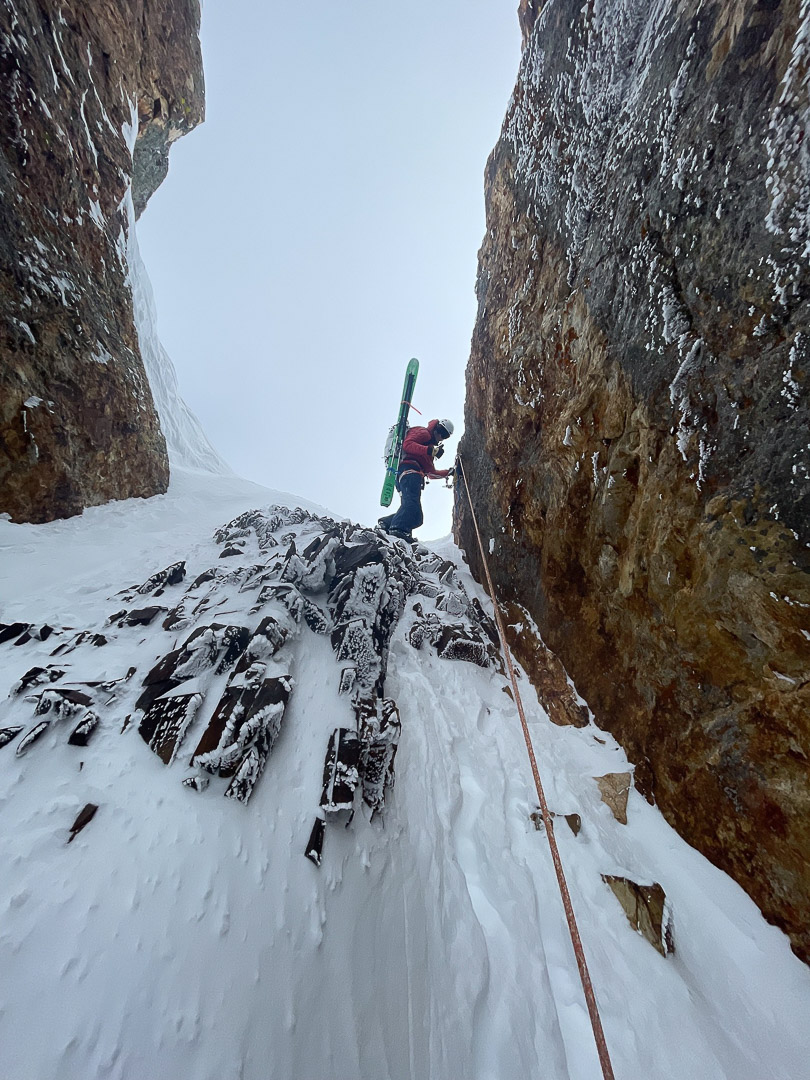
Oh the places we go. Safe travel sometimes requires the use of fixed anchors. New proposals could put their placement in designated wilderness into question. Photo: Billy Haas.
There’s a full-blown policy debate—a heated one—around fixed climbing anchors in federally designated Wilderness. We present some fundamental elements about the current fixed anchor schism.
Background
The Wilderness Act passed in 1964, created the National Wilderness Preservation System with large and small wilderness units managed by the National Park Service, Forest Service, Bureau of Land Management, and the Fish and Wildlife Service. We often think of wilderness areas as having “primeval character” and landscapes and ecosystems absent most (if not all) human-made improvements or habitation. Many know wilderness areas as zones absent motors, including bikes and drones. We also know these areas to be fine places for adventure climbing and skiing/riding.
Below is an interactive map displaying Wilderness Areas in the U.S.
The Proposals
Two proposals, one by the National Park Service (Department of Interior) and the other by the Forest Service (Department of Agriculture), aim to redefine how the agencies interpret pre-existing and future climbing anchors in wilderness. For more clarity about the fixed anchor issue, we’ll jump ahead to page 5 in that document and zero in on the highlighted language below:
“PROHIBITION OF CERTAIN USES
(c) Except as specifically provided for in this Act, and subject to existing private rights, there shall be no commercial enterprise and no permanent road within any wilderness area designated by this Act and except as necessary to meet minimum requirements for the administration of the area for the purpose of this Act (including measures required in emergencies involving the health and safety of persons within the area), there shall be no temporary road, no use of motor vehicles, motorized equipment or motorboats, no landing of aircraft, no other form of mechanical transport, and no structure or installation within any such area.”
The statement “there shall be no structure…or installation within any such area” holds the key to this potential new interpretation. The two proposals aim to define climbing anchors as permanent installations. For reference, the NPS defines an installation as “Anything made by humans that is not intended for human occupation and is left unattended or left behind when the installer leaves the wilderness.”
Read the NPS fixed anchors in Wilderness proposal (scroll to bottom).
The permanent installation concept we’re addressing applies only in Congressionally designated Wilderness. For example, in Yosemite Valley, any zone above 4,500 feet (about 500 feet above the Valley floor) is designated wilderness. Those mega-clusters of canvas tents, high-density tent-cities, and paved loops on the valley floor are outside wilderness.
In contrast, Teton National Park has no Congressionally designated wilderness. That does not mean fixed anchors in the alpine there, of which there are many, are immune from the new interpretation. The Teton National Park website states the park has areas that are recommended, potential, or eligible wilderness. “By National Park Service policy, recommended, potential and eligible wilderness is managed the same as designated wilderness,” in the park.
The High Route doesn’t deal with constitutional law. But a literal reading of the Wilderness Act might support a claim that climbing anchors are permanent installations. If you interpret the Act this way, or these proposals are enacted, in wilderness you might be downclimbing instead of rappelling any ski line (or climbing descent route) with mandatory rappels.
However, all this doesn’t mean poof; there’s instant removal of, and ban on new fixed anchors if the proposed rules/interpretations reign. It could, however, easily trend in that direction. The wiggle room provided by the suggested policies isn’t much. Pre-existing and new anchors would be analyzed through a MRA, or Minimum Requirement Analysis, to determine if an anchor is approved or disallowed.
Read through section 3 of the NPS proposal; one thing is clear regarding the MRA—red tape.
Climbers and ski mountaineers often decide about anchor placements in real-time, as the terrain dictates—this is certainly the case when establishing a new climbing route or first descent. Fixed anchors are important tools for safe travel through the mountains. It remains unclear how the installation and use of unapproved fixed anchors would be enforced. (Half written in jest—Yosemite Valley has its own jail which is not a far jog from Camp 4 or the base of El Cap.)
Problem Solving
There has been relatively little buzz within the backcountry ski/riding communities. But there’s a high-watt buzz among climbing advocacy groups. The American Alpine Club and Access Fund are helping lead the policy fight on behalf of climbers. (Disclaimer: several of us at The High Route belong to the AAC.)
A document linked through the AAC website helps explore the issue and specifically cites the Protecting America’s Rock Climbing (PARC) Act as a clear path to preserve Wilderness climbing with the use of fixed anchors. According to the document, the PARC Act will:
- Require federal agencies to recognize recreational climbing as an appropriate activity in accordance with the Wilderness Act of 1964.
- State that the placement, use, and maintenance of fixed anchors is appropriate.
- Ensure a public comment period is made available prior to any final climbing management guidance being issued.
Wilderness climbing in designated wilderness predates, by many decades, the 1964 Wilderness Act. Here and there, over the years, local Park superintendents or Forest supervisors have tried to interpret fixed anchors in wilderness as installations. Occasionally, guidelines are established to prevent willy-nilly bolting. However, in good faith, the climbing community and land managers have worked out major differences over the years. Our community has been afforded safe passage in these wild places by using pitons, webbing, and bolts to ensure we come home safe.
The period for commenting on the NPS and FS proposals has been extended to January 30. No matter how you side on the issue, it has been suggested that you include personal experiences in submitted comments.
Comment on the NPS proposal here.
Comment on the FS proposal here.
